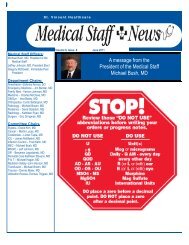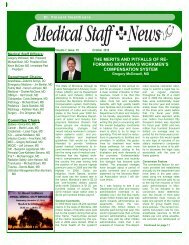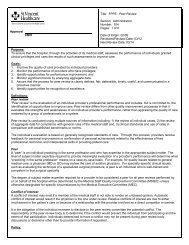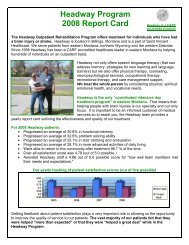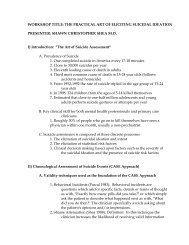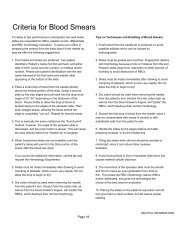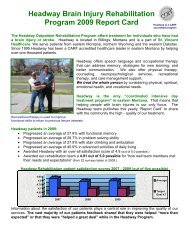AHA/ASA Guideline Guidelines for the Prevention of Stroke in ...
AHA/ASA Guideline Guidelines for the Prevention of Stroke in ...
AHA/ASA Guideline Guidelines for the Prevention of Stroke in ...
You also want an ePaper? Increase the reach of your titles
YUMPU automatically turns print PDFs into web optimized ePapers that Google loves.
266 <strong>Stroke</strong> January 2011erythrocyte receptors <strong>in</strong> patients after myocardial <strong>in</strong>farction. J CardiopulmRehabil. 1999;19:98–105.129. Kohrt WM, Kirwan JP, Staten MA, Bourey RE, K<strong>in</strong>g DS, Holloszy JO.Insul<strong>in</strong> resistance <strong>in</strong> ag<strong>in</strong>g is related to abdom<strong>in</strong>al obesity. Diabetes.1993;42:273–281.130. From <strong>the</strong> Centers <strong>for</strong> Disease Control and <strong>Prevention</strong>. Physical activitytrends–United States, 1990–1998. JAMA. 2001;285:1835.131. Katzmarzyk PT, Gledhill N, Shephard RJ. The economic burden <strong>of</strong>physical <strong>in</strong>activity <strong>in</strong> Canada. CMAJ. 2000;163:1435–1440.132. American <strong>Stroke</strong> Association. <strong>Stroke</strong> Facts 2003: All Americans. Dallas,TX: American <strong>Stroke</strong> Association; 2004.133. Gordon NF, Gulanick M, Costa F, Fletcher G, Frankl<strong>in</strong> BA, Roth EJ,Shephard T. Physical activity and exercise recommendations <strong>for</strong> strokesurvivors: an American Heart Association scientific statement from <strong>the</strong>Council on Cl<strong>in</strong>ical Cardiology, Subcommittee on Exercise, CardiacRehabilitation, and <strong>Prevention</strong>; <strong>the</strong> Council on Cardiovascular Nurs<strong>in</strong>g;<strong>the</strong> Council on Nutrition, Physical Activity, and Metabolism; and <strong>the</strong><strong>Stroke</strong> Council. <strong>Stroke</strong>. 2004;35:1230–1240.134. Duncan P, Studenski S, Richards L, Gollub S, Lai SM, Reker D, PereraS, Yates J, Koch V, Rigler S, Johnson D. Randomized cl<strong>in</strong>ical trial <strong>of</strong><strong>the</strong>rapeutic exercise <strong>in</strong> subacute stroke. <strong>Stroke</strong>. 2003;34:2173–2180.135. Fletcher GF, Balady GJ, Amsterdam EA, Chaitman B, Eckel R, Fleg J,Froelicher VF, Leon AS, P<strong>in</strong>a IL, Rodney R, Simons-Morton DA,Williams MA, Bazzarre T. Exercise standards <strong>for</strong> test<strong>in</strong>g and tra<strong>in</strong><strong>in</strong>g: astatement <strong>for</strong> healthcare pr<strong>of</strong>essionals from <strong>the</strong> American Heart Association.Circulation. 2001;104:1694–1740.136. MacKay-Lyons MJ, Makrides L. Cardiovascular stress dur<strong>in</strong>g a contemporarystroke rehabilitation program: is <strong>the</strong> <strong>in</strong>tensity adequate to<strong>in</strong>duce a tra<strong>in</strong><strong>in</strong>g effect? Arch Phys Med Rehabil. 2002;83:1378–1383.137. Sacco RL, Gan R, Boden-Albala B, L<strong>in</strong> IF, Kargman DE, Hauser WA,Shea S, Paik MC. Leisure-time physical activity and ischemic strokerisk: <strong>the</strong> Nor<strong>the</strong>rn Manhattan <strong>Stroke</strong> Study. <strong>Stroke</strong>. 1998;29:380–387.138. Leoo T, L<strong>in</strong>dgren A, Petersson J, von Arb<strong>in</strong> M. Risk factors andtreatment at recurrent stroke onset: results from <strong>the</strong> Recurrent <strong>Stroke</strong>Quality and Epidemiology (RESQUE) Study. Cerebrovasc Dis. 2008;25:254–260.139. Toyoda K, Okada Y, Kobayashi S. Early recurrence <strong>of</strong> ischemic stroke<strong>in</strong> Japanese patients: <strong>the</strong> Japan standard stroke registry study. CerebrovascDis. 2007;24:289–295.140. Xu G, Liu X, Wu W, Zhang R, Y<strong>in</strong> Q. Recurrence after ischemic stroke<strong>in</strong> Ch<strong>in</strong>ese patients: impact <strong>of</strong> uncontrolled modifiable risk factors.Cerebrovasc Dis. 2007;23:117–120.141. Greenlund KJ, Giles WH, Keenan NL, Cr<strong>of</strong>t JB, Mensah GA. Physicianadvice, patient actions, and health-related quality <strong>of</strong> life <strong>in</strong> secondaryprevention <strong>of</strong> stroke through diet and exercise. <strong>Stroke</strong>. 2002;33:565–570.142. Grundy SM. Metabolic syndrome: connect<strong>in</strong>g and reconcil<strong>in</strong>g cardiovascularand diabetes worlds. J Am Coll Cardiol. 2006;47:1093–1100.143. Reaven GM. Role <strong>of</strong> <strong>in</strong>sul<strong>in</strong> resistance <strong>in</strong> human disease. Diabetes.1988;37:1595–1606.144. Despres J-P. Abdom<strong>in</strong>al obesity as important component <strong>of</strong> <strong>in</strong>sul<strong>in</strong>resistancesyndrome. Nutrition. 1993;9:452–459.145. Chen W, Sr<strong>in</strong>ivasan SR, Elkasabany A, Berenson GS. Cardiovascularrisk factors cluster<strong>in</strong>g features <strong>of</strong> <strong>in</strong>sul<strong>in</strong> resistance syndrome (syndromeX) <strong>in</strong> a biracial (black-white) population <strong>of</strong> children, adolescents, andyoung adults: <strong>the</strong> Bogalusa Heart Study. Am J Epidemiol. 1999;150:667–674.146. Chen W, Sr<strong>in</strong>ivasan SR, Elkasabany A, Berenson GS. The association <strong>of</strong>cardiovascular risk factor cluster<strong>in</strong>g related to <strong>in</strong>sul<strong>in</strong> resistancesyndrome (syndrome X) between young parents and <strong>the</strong>ir <strong>of</strong>fspr<strong>in</strong>g: <strong>the</strong>Bogalusa Heart Study. A<strong>the</strong>rosclerosis. 1999;145:197–205.147. Sakk<strong>in</strong>en PA, Wahl P, Cushman M, Lewis MR, Tracy RP. Cluster<strong>in</strong>g <strong>of</strong>procoagulant, <strong>in</strong>flammation, and fibr<strong>in</strong>olysis variables with metabolicfactors <strong>in</strong> <strong>in</strong>sul<strong>in</strong> resistance syndrome. Am J Epidemiol. 2000;152:897–907.148. Grundy SM, Cleeman JI, Daniels SR, Donato KA, Eckel RH, Frankl<strong>in</strong>BA, Gordon DJ, Krauss RM, Savage PJ, Smith SC Jr, Spertus JA, CostaF. Diagnosis and management <strong>of</strong> <strong>the</strong> metabolic syndrome: an AmericanHeart Association/National Heart, Lung, and Blood Institute ScientificStatement. Circulation. 2005;112:2735–2752.149. Moller DE, Flier JS. Insul<strong>in</strong> resistance: mechanisms, syndromes, andimplications. N Engl J Med. 1991;325:938–948.150. Ivey FM, Ryan AS, Hafer-Macko CE, Goldberg AP, Macko RF.Treadmill aerobic tra<strong>in</strong><strong>in</strong>g improves glucose tolerance and <strong>in</strong>dices <strong>of</strong><strong>in</strong>sul<strong>in</strong> sensitivity <strong>in</strong> disabled stroke survivors: a prelim<strong>in</strong>ary report.<strong>Stroke</strong>. 2007;38:2752–2758.151. Esposito K, Marfella R, Ciotola M, DiPalo C, Giugliano F, Giugliano G,D’Armiento M, D’Andrea F, Giugliano D. Effect <strong>of</strong> a Mediterranean-stylediet on endo<strong>the</strong>lial dysfunction and markers <strong>of</strong> vascular <strong>in</strong>flammation <strong>in</strong> <strong>the</strong>metabolic syndrome: a randomized trial. JAMA. 2004;292:1440–1446.152. Hanefeld M, Marx N, Pfutzner A, Baurecht W, Lubben G, KaragiannisE, Stier U, Forst T. Anti-<strong>in</strong>flammatory effects <strong>of</strong> pioglitazone and/orsimvastat<strong>in</strong> <strong>in</strong> high cardiovascular risk patients with elevated high sensitivityC-reactive prote<strong>in</strong>. J Am Coll Cardiol. 2007;49:290–297.153. Deedwania P, Barter P, Carmena R, Fruchart J-C, Grundy SM, HaffnerS, Kastele<strong>in</strong> JJP, LaRosa JC, Schachner H, Shepherd J, Waters DD; <strong>for</strong><strong>the</strong> Treat<strong>in</strong>g to New Targets Investigators. Reduction <strong>of</strong> low-densitylipoprote<strong>in</strong> cholesterol <strong>in</strong> patients with coronary heart disease and metabolicsyndrome: analysis <strong>of</strong> <strong>the</strong> Treat<strong>in</strong>g to New Targets study. Lancet.2006;368:919–928.154. Giugliano D, Ceriello A, Esposito K. Are <strong>the</strong>re specific treatments <strong>for</strong><strong>the</strong> metabolic syndrome? Am J Cl<strong>in</strong> Nutr. 2008;87:8–11.155. Tjonna AE, Lee SJ, Rognmo O, Stolen TO, Bye A, Haram PM, LoennechenJP, Al-Share QY, Skoguvoll E, Slordahl SA, Kemi OJ, NajjarSM, Wisl<strong>of</strong>f U. Aerobic <strong>in</strong>terval tra<strong>in</strong><strong>in</strong>g versus cont<strong>in</strong>uous moderateexercise as a treatment <strong>for</strong> <strong>the</strong> metabolic syndrome: a pilot study.Circulation. 2008;118:346–354.156. Ford ES, Giles WH, Dietz WH. Prevalence <strong>of</strong> <strong>the</strong> metabolic syndromeamong US adults. JAMA. 2002;287:356–359.157. Bang OY, Kim JW, Lee JH, Lee MA, Lee PH, Joo IS, Huh K. Association<strong>of</strong> <strong>the</strong> metabolic syndrome with <strong>in</strong>tracranial a<strong>the</strong>roscleroticstroke. Neurology. 2005;65:296–298.158. Milionis HJ, Rizos E, Goudevenos J, Seferiadis K, Mikhailidis DP,Elisaf MS. Components <strong>of</strong> <strong>the</strong> metabolic syndrome and risk <strong>for</strong>first-ever ischemic nonembolic stroke <strong>in</strong> elderly subjects. <strong>Stroke</strong>. 2005;36:1372–1376.159. Gorter PM, Olijhoek JK, van der Graff Y, Algra A, Rabel<strong>in</strong>k TJ,Visseren FL; Smart Study Group. Prevalence <strong>of</strong> <strong>the</strong> metabolic syndrome<strong>in</strong> patients with coronary heart disease, cerebrovascular disease, peripheralarterial disease or abdom<strong>in</strong>al aortic aneurysm. A<strong>the</strong>rosclerosis.2004;173:363–369.160. Eckel RH, Grundy SM, Zimmet PZ. The metabolic syndrome. Lancet.2005;365:1415–1428.161. Sattar N, McConnachie A, Shaper AG, Blauw GJ, Buckley BM, deCraen AJ, Ford I, Forouhi NG, Freeman DJ, Jukema JW, Lennon L,Macfarlane PW, Murphy MB, Packard CJ, Stott DJ, Westendorp RG,Wh<strong>in</strong>cup PH, Shepherd J, Wanname<strong>the</strong>e SG. Can metabolic syndromeusefully predict cardiovascular disease and diabetes? Outcome data fromtwo prospective studies. Lancet. 2008;371:1927–1935.162. Boden-Albala B, Sacco RL, Lee H-S, Grahame-Clarke C, Rundek T,Elk<strong>in</strong>d MV, Wright C, Giard<strong>in</strong>a E-GV, DiTullio MR, Homma S, PaikMC. Metabolic syndrome and ischemic stroke risk: Nor<strong>the</strong>rn ManhattanStudy. <strong>Stroke</strong>. 2008;39:30–35.163. Kurl S, Laukkanen JA, Niskanen L, Laaksonen D, Sivenius J, NyyssonenK, Salonen JT. Metabolic syndrome and <strong>the</strong> risk <strong>of</strong> stroke <strong>in</strong>middle-aged men. <strong>Stroke</strong>. 2006;37:806–811.164. Kwon H-M, Kim BJ, Lee S-H, Choi SH, Oh B-H, Yoon BW. Metabolicsyndrome as an <strong>in</strong>dependent risk factor <strong>of</strong> silent bra<strong>in</strong> <strong>in</strong>farction <strong>in</strong>healthy people. <strong>Stroke</strong>. 2006;37:466–470.165. Koren-Morag N, Goldbourt U, Tanne D. Relation between <strong>the</strong> metabolicsyndrome and ischemic stroke or transient ischemic attack: a prospectivestudy <strong>in</strong> patients with a<strong>the</strong>rosclerotic cardiovascular disease. <strong>Stroke</strong>.2005;36:1366–1371.166. Najarian RM, Sullivan LM, Kannel WB, Wilson PWF, D’Agost<strong>in</strong>o RB,Wolf PA. Metabolic syndrome compared with type 2 diabetes mellitusas a risk factor <strong>for</strong> stroke. Arch Intern Med. 2006;166:106–111.167. Chen HJ, Bai CH, Yeh W-T, Chiu H-C, Pan W-H. Influence <strong>of</strong> metabolicsyndrome and general obesity on <strong>the</strong> risk <strong>of</strong> ischemic stroke.<strong>Stroke</strong>. 2006;37:1060–1064.168. Protopsaltis I, Korantzopoulos P, Milionis HJ, Koutsovasilis A, NikolopoulosGK, Dimou E, Kokkoris S, Brestas P, Elisaf MS, Melidonis A.Metabolic syndrome and its components as predictors <strong>of</strong> ischemic stroke<strong>in</strong> type 2 diabetic patients. <strong>Stroke</strong>. 2008;39:1036–1038.169. Qiao Q, Laatika<strong>in</strong>en T, Ze<strong>the</strong>lius B, Stegmayr B, Eliasson M, JousilahtiP, Tuomilehto J. Comparison <strong>of</strong> def<strong>in</strong>itions <strong>of</strong> metabolic syndrome <strong>in</strong>relation to <strong>the</strong> risk <strong>of</strong> develop<strong>in</strong>g stroke and coronary heart disease <strong>in</strong>F<strong>in</strong>nish and Swedish cohorts. <strong>Stroke</strong>. 2009;40:337–343.Downloaded from stroke.ahajournals.org by on March 8, 2011



